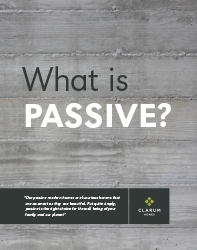What is Passive?
What makes a passive home?
A passive home is an extremely comfortable, healthy, economical, and sustainable home, designed and constructed to use up to 90% less energy than a traditional home. What’s more, these efficiency gains aren’t due to some constrained design approach. Passive homes are elegant, comfortable living spaces that can be designed to meet your lifestyle, aesthetic tastes, and stylistic preferences.

Here is a list of the features that make a passive home so healthy, comfortable, and sustainable:
1) Solar Power System
Increases energy independence, produces electricity from sun, and reduces carbon footprint. MORE »
2) Heat Recovery Ventilator (HRV)
Provides continuous fresh air, exhausts stale air, and recovers 90% of heat from exhausted air. MORE »
3) Solar Tube
Provides natural light and saves energy.
4) Insulation and High Efficiency Framing
Provides conditioned, sealed attic. MORE »
5) Super Insulated Roof
SIPS provide vaulted ceilings with super insulation and high efficiency framing
provides conditioned, sealed attic.
6) Front Loading Washer
Saves energy, conserves water and is less damaging to clothes.
7) Condensing Dryer
Does not require venting, dries clothing at lower temperature, and saves energy.
8) Structural Insulated Panels (SIPS)
SIPS walls reduce heating and cooling load, super insulated walls keep indoor temperature constant, and SIPS walls are stronger, straighter and more durable. MORE »
9) Solar Hot Water System
Utilizes sun to heat water (85%), provides energy for home heating, and increases energy independence. MORE »
10) Electric Car Charger
Allows car charging using smart grid technology.
11) Drought Tolerant Landscaping
Conserves water.
12) Integrated Pavers
Permeable pavers improve landscape drainage.
13) Air & Moisture Barrier
Water based liquid applied elastomeric barrier provides air tight construction and is made with 25% recycled content.
14) High Performance Windows
High performance triple-glazed windows increases comfort in the home, decreases energy use and reduces condensation. MORE »
15) Interior Air Sealing
Greatly reduced thermal bridging eliminates drafts, saves energy, and keeps temperatures constant.
16) Insulated Exterior (Outsulation)
Provides super insulated exterior walls and breaks thermal bridge.
Up to 90% reduction in energy use?
Passive homes are very well-insulated and virtually air-tight, which greatly minimizes the loss of heat. This means no furnace (you read that right) and extreme energy efficiency. All of the heating in a typical passive home can be met by a single 1000-watt heater. Heat from people, lights, appliances and the sun does the rest.
And in the hotter months, the home stays delightfully cool without the need for air conditioning. Shading and well-planned window orientation helps to keep the house at a comfortable temperature.
An energy recovery ventilator provides a constant, balanced fresh air supply. The result is an impressive system that not only saves up to 90% of space heating costs, but also provides healthy indoor air quality.
Unlike “point accumulation” green building standards, Passive home certification is based on actual performance results that require the that the home uses less than 1.4kWh per square foot for annual heating demand and total annual source energy cannot exceed 11kWh per square foot. In addition the building shell must be airtight with less than 0.6 air changes per hour at 50 pascals.







